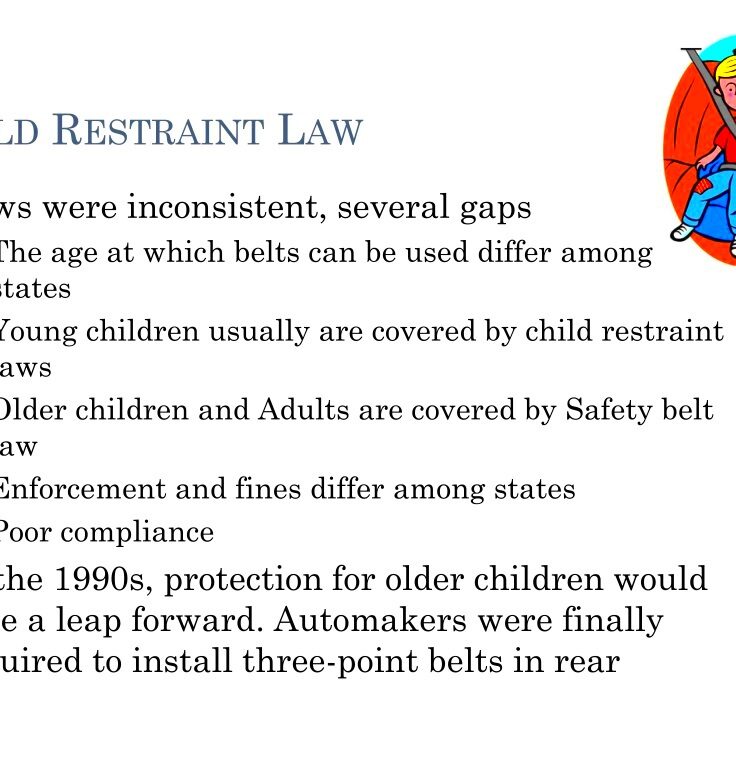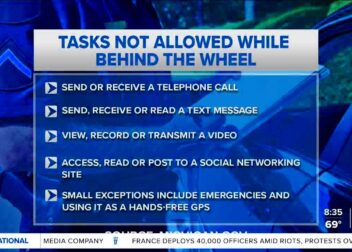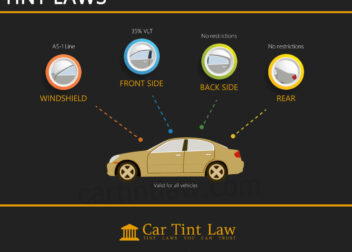Compliance and Enforcement of Child Restraint Laws in Louisiana
In Louisiana, keeping children safe on the road is a priority. The state has laws in place to protect young passengers from getting hurt in case of an accident. These laws require that children are secured in suitable restraint systems according on their age, weight and height. If you’ve ever had a child as a passenger you understand the comfort that comes from knowing they are safely strapped in. However it’s essential to be aware of the details of Louisianas regulations to make sure you’re following the rules.
In Louisiana the legal framework is well defined and designed to ensure utmost safeguarding.
- Infants: Must be secured in a rear-facing car seat until they are at least one year old and weigh 20 pounds.
- Toddlers: Once they outgrow the rear-facing seat, they should transition to a forward-facing seat with a harness. This must be used until they are 4 years old or weigh 40 pounds.
- Preschoolers: Should use a booster seat until they are 8 years old or 57 inches tall.
- Older Children: Once they exceed the booster seat requirements, they must use a seatbelt until they are 13 years old or until they fit properly in an adult seatbelt.
These rules serve as more than mere suggestions; they are binding rules designed to mitigate the chances of accidents. Witnessing the impact of these laws firsthand can be quite revealing watching a child snugly fastened in their seat brings about an undeniable feeling of comfort and security.
Key Requirements for Different Age Groups
It’s important to know the rules for different age groups when it comes to Louisiana’s child restraint laws. As children grow up they need different kinds of restraints to keep them safe. Lets take a look at the requirements for each stage of development.
- Infants (0-1 year): They must be placed in a rear-facing car seat. This is the safest position for infants, as it provides the best protection for their head, neck, and spine during a crash.
- Toddlers (1-4 years): Transition to a forward-facing car seat with a harness. This seat should have a five-point harness to secure the child effectively.
- Preschoolers (4-8 years): A booster seat is necessary to elevate the child so that the seatbelt fits properly. Ensure the booster seat is appropriate for their weight and height.
- Older Children (8-13 years): They should use a seatbelt that fits properly. It’s important that the lap belt lies snugly across their upper thighs and the shoulder belt crosses the middle of their chest.
Every change in a child safety measure plays a role in keeping them secure. Being mindful of these guidelines ensures that kids are protected based on their age and development. I remember when my niece had to move on from her car seat switching to a booster seat was a mix of emotions for me. It marked her growing up but it also brought comfort knowing she was still safely strapped in.
Penalties for Non-Compliance
Disregarding Louisiana’s child seat laws can result in serious repercussions. The state prioritizes the safety of young passengers and breaking these rules can lead to penalties. Here’s what you should be aware of.
- Fines: Failure to properly restrain a child can result in a fine, typically starting around $100. Repeated offenses can lead to higher fines.
- Points on Driving Record: Non-compliance may also result in points being added to your driving record, which could impact your insurance rates and driving privileges.
- Legal Consequences: In severe cases, especially if non-compliance results in an injury, there could be additional legal repercussions.
These consequences are meant to emphasize the significance of following the rules. Its not solely about steering clear of penalties; its also about safeguarding the health and safety of your kids. I remember witnessing a friend getting pulled over for failing to use a seat. That moment served as a reminder for everyone about the importance of abiding by these regulations to protect our little ones.
How to Ensure Compliance with Child Restraint Laws
Following Louisiana’s child restraint laws isn’t solely about steering clear of fines; it’s also about protecting your child’s safety. While keeping up with these rules may feel daunting, it’s doable with the mindset and support. Having gone through this process I recognize the importance of being well informed and taking action.
Here are some useful suggestions to assist you in maintaining compliance.
- Choose the Right Car Seat: Invest in a car seat that fits your child’s current age, weight, and height. Always check the manufacturer’s guidelines and ensure the seat is properly installed. Many parents find it helpful to have their car seat installation checked by a professional.
- Regularly Check for Updates: Child restraint laws can change, so it’s important to stay updated. Sign up for newsletters from local safety organizations or check government websites for the latest information.
- Educate Yourself and Others: Understanding the laws is one thing, but sharing this knowledge with family members and caregivers ensures that everyone involved is on the same page. I remember having to explain the importance of these laws to my extended family—it made a difference in how we all approached child safety.
- Use the Right Installation Techniques: Follow the installation instructions meticulously. Many car seats come with detailed manuals, and if you’re unsure, seek assistance from a certified technician. Proper installation is key to the effectiveness of the car seat.
Keeping yourself updated and taking action can help you make sure that your child is securely buckled up during car rides. It may seem like a task but it brings reassurance and security for your kids.
Role of Law Enforcement in Enforcing Restraint Laws
The police play a role in enforcing Louisiana’s laws regarding child restraint. Their presence on the roads acts as a way to discourage violations and uphold safety rules that are meant to safeguard children.
Law enforcement plays a role in supporting this cause in the following ways.
- Traffic Stops and Inspections: Officers routinely check for compliance during traffic stops. If a vehicle is pulled over for any reason, officers may inspect the child restraint systems to ensure they meet legal requirements.
- Education and Outreach: Law enforcement agencies often engage in community outreach programs to educate parents about the importance of child safety seats. These programs can include workshops, demonstrations, and informational pamphlets.
- Issuing Citations: When non-compliance is detected, officers issue citations. These penalties serve to reinforce the importance of following the laws and prompt corrective action from parents.
- Collaboration with Safety Organizations: Officers frequently work with organizations that focus on child passenger safety. This collaboration helps spread awareness and provides additional resources for parents.
Witnessing the commitment of officers at community events I can vouch for their dedication to keeping children safe. Their work plays a role in ensuring that kids are securely buckled up which greatly enhances road safety.
Recent Changes and Updates to the Laws
Child safety seat laws can change and be updated based on the latest research and advancements in technology. Staying informed about these updates ensures that you are following the regulations and offering the best safety for your little one.
Recent changes to the child restraint laws in Louisiana include.
- Updated Age and Size Requirements: New regulations have refined the age and size requirements for car seats and booster seats. For example, the minimum weight for transitioning from a rear-facing to a forward-facing seat has been adjusted to better align with safety recommendations.
- Enhanced Penalty Provisions: Penalties for non-compliance have been updated to reinforce the importance of adhering to the laws. This includes increased fines and points on the driving record for repeat offenders.
- Technological Advances in Car Seats: Regulations now take into account the latest advancements in car seat technology. This ensures that the laws reflect current safety standards and provide the highest level of protection for children.
Keeping up with these changes can really help you stay in line with the rules. I’ve noticed that taking the time to go through updates and chatting about them with other parents is beneficial for staying well prepared when it comes to ensuring the safety of children.
Common Misconceptions About Child Restraint Laws
Child restraint laws aim to protect our kids but misunderstandings about these rules can result in confusion and non adherence. As a parent who has dealt with these regulations I’ve encountered several widespread myths that often cause misinterpretations. Lets set the record straight on some of these misconceptions so that everyone can effectively follow the laws and ensure the safety of their children.
- Myth 1: “My child’s car seat is outdated; it’s still safe if it looks fine.” Many believe that as long as a car seat looks in good condition, it’s safe to use. However, car seats have expiration dates due to the wear and tear of materials over time. It’s crucial to check the expiration date and replace the seat if needed.
- Myth 2: “A seatbelt is sufficient for all children once they reach a certain age.” While seatbelts are essential, they are not always suitable for younger children. Booster seats are required to ensure that the seatbelt fits properly across the child’s body. Using a seatbelt too early can be dangerous.
- Myth 3: “It’s okay to move to a forward-facing car seat once the child hits the weight limit.” Weight is just one factor. Height and developmental stage also play a role. Following the car seat manufacturer’s guidelines is crucial for ensuring safety.
- Myth 4: “Child restraint laws are the same everywhere.” Laws vary from state to state, and it’s important to be aware of the specific regulations in Louisiana. What’s permissible in one state might not be in another.
It’s crucial to clarify these misunderstandings to protect our children. I remember being puzzled by these regulations when my kid was small. Comprehension and compliance play a role in ensuring the safety of our youngsters while driving.
Resources for Parents and Caregivers
Locating trustworthy and dependable sources can simplify the process of understanding child restraint laws. As a parent I have come across a range of resources that are essential for ensuring adherence to the rules and safeguarding children. Here are some helpful materials to keep you well informed and ready.
- Government Websites: Websites like the National Highway Traffic Safety Administration (NHTSA) and the Louisiana Highway Safety Commission provide up-to-date information on car seat regulations, safety tips, and recall notices.
- Local Safety Programs: Many communities offer car seat safety checks and educational programs. These programs often provide hands-on assistance with car seat installation and offer valuable advice on keeping your child safe.
- Parenting Forums and Support Groups: Online forums and local parenting groups can be great sources of advice and shared experiences. They often have discussions about the latest safety recommendations and laws.
- Certified Child Passenger Safety Technicians: These professionals can help ensure that your car seat is installed correctly. Their expertise is invaluable for making sure that the seat meets all safety standards.
Utilizing these resources can bring a sense of reassurance and help you take every measure to safeguard your childs well being. Personally I’ve discovered that getting involved with these materials not only aids in grasping the legal aspects but also fosters a community of like minded parents and caregivers for support.
Frequently Asked Questions
Grasping the laws regarding child restraints can lead to inquiries. Here are a few of the questions along with responses that aim to address common worries.
- Q: How do I know if my child’s car seat is installed correctly? A: Ensure that the car seat is tightly secured and doesn’t move more than an inch from side to side. The harness should fit snugly, with the straps lying flat against your child’s chest.
- Q: What should I do if my child outgrows their car seat? A: Transition your child to the next appropriate seat based on their age, weight, and height. Follow the manufacturer’s guidelines for each type of car seat to ensure proper use.
- Q: Are there any exemptions to the child restraint laws? A: Certain exemptions might apply in specific situations, such as medical conditions. However, these are rare, and it’s best to consult with a professional for guidance if you believe an exemption might apply.
- Q: How often should I check my car seat for safety? A: Regularly check your car seat for any signs of wear and tear and ensure that it’s installed correctly. It’s a good practice to have it inspected periodically, especially if you’ve recently been involved in an accident.
These frequently asked questions tackle the worries that parents often face. I recall struggling with similar queries and discovering these responses to be immensely valuable in safeguarding my childs well being while driving.
Conclusion
Complying with child restraint laws in Louisiana goes beyond being a requirement; it’s a vital measure to protect your child’s safety. Whether it’s understanding the details of each law dispelling myths or accessing available resources every aspect of these regulations is crafted with your child’s security at heart. I’ve personally witnessed the challenges and rewards that come with ensuring adherence to these laws and the reassurance that comes from knowing my child is safe during every trip is truly priceless. By staying up to date connecting with community resources and putting our knowledge into practice we can enhance road safety for everyone. It’s an effort that yields significant safety advantages making a world of difference for our little ones.


